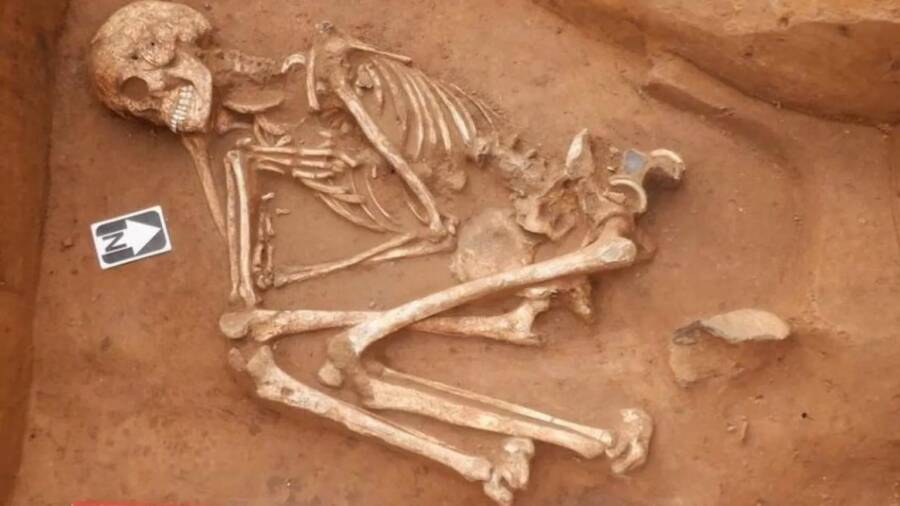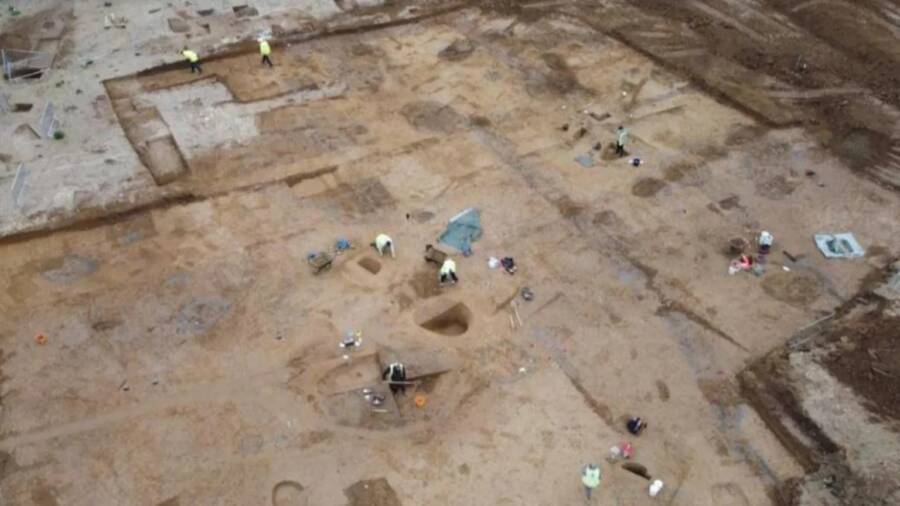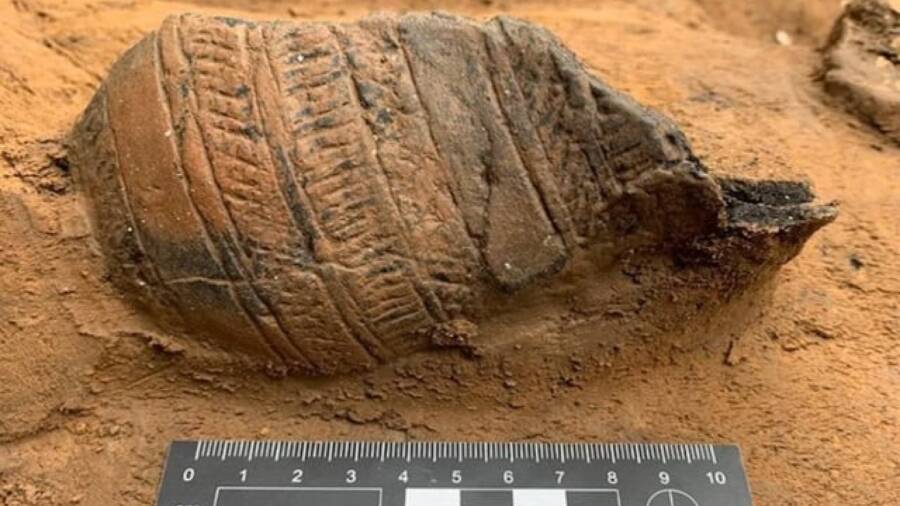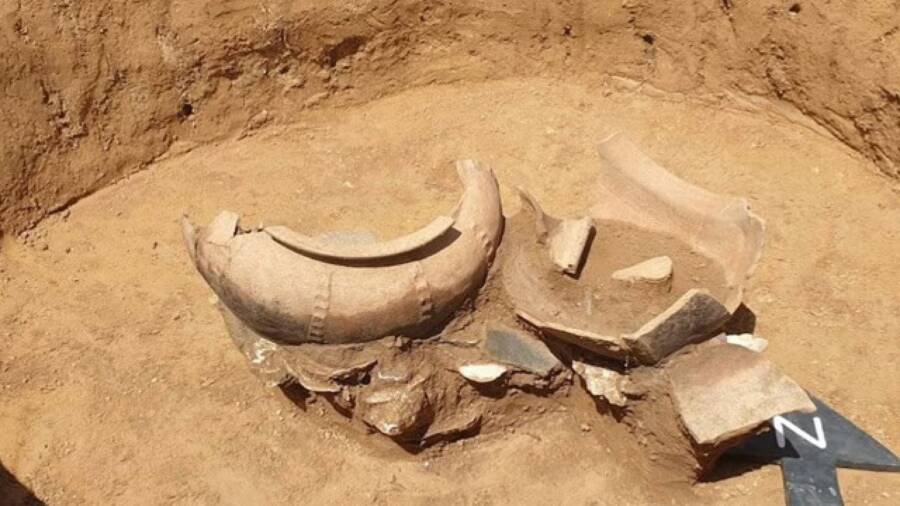The skeleton was found alongside a number of other objects from the Bronze Age, including flint and pottery fragments.

SWAT ArchaeologyThe Bronze Age skeleton will be archived in a museum.
During an archaeological survey ahead of a neighborhood construction project in England, archaeologists came across the well-preserved skeleton of a Bronze Age woman. But that’s not all they found.
The surprise dig turned up a number of other objects as well, from the Bronze Age and beyond. As one archaeologist on the site commented, such discoveries tell a story about Britain’s long history.
Discovering The Bronze Age Skeleton In Thanet
According to local media, the Bronze Age skeleton was unearthed ahead of a 2021 construction project on the Isle of Thanet, a peninsula located on the easternmost part of Kent, England. At the site in Cliffsend, which was earmarked for 41 new homes, Swale and Thames Archaeological Survey Company (SWAT Archaeology) came across the almost complete skeleton.

SWAT ArchaeologyThe site in Thanet where the Bronze Age woman was discovered alongside other human remains and Bronze Age objects.
“Coming into the job it was very likely that we would encounter burials on site due to there being several archaeological excavations within the surrounding vicinity of the site that have recorded burial landscapes from the Early Bronze Age through to at least the Anglo-Saxon period,” Dan Worsley, the site project manager, told All That’s Interesting in an email. “We had some idea of the scale and significance of the archaeology on site but of course there are always still surprises… We think that we… caught the edge of an Early Bronze Age cemetery, located to the south.”
The woman, who archaeologists believe was between the ages of 30 and 35, was found in a curled position in a burial pit. This is called a “crouch burial” — a common practice in the Bronze Age — and involves the dead being buried on their sides with their knees pulled up to their chests.
“The individual’s good oral health, affected only by a slight calcified dental plaque, suggested a low intake of food sugars and suboptimal dental hygiene,” Worsley explained to All That’s Interesting, noting that the skeleton’s average height suggested that she didn’t have a “privileged” position in Bronze Age society. “The individual had stress related trauma that affected four lumbar vertebrae, suggestive of disc degeneration. The individual also presented a lytic lesion of the front of the pelvis, a fracture where the bone is pulled away from the main bone mass by a sudden powerful muscle contraction, an injury prevalent in modern day athletes.”
In addition to the nearly complete skeleton, archaeologists also uncovered the partial remains of other people — including a skull fragment from a young woman who died between 500 and 400 B.C.E.
Thrillingly, that’s not all they found in the area, which archaeologists say was the site of “prolonged occupations” for hundreds of years from the Bronze Age until the post-medieval period.
The Historical Significance Of The Thanet Site
In addition to the Bronze Age human remains, archaeologists also made other discoveries at the site. They uncovered ditches, enclosures, evidence of a Roman road, and what appears to be a prehistoric “monumental” ditch containing a Beaker burial (a custom in Britain between 2500 B.C.E. and 1800 B.C.E. in which the deceased were buried with distinctive pots).

SWAT ArchaeologyThe pot found in the Beaker burial at the site.
Archaeologists also found flint, pottery, and animal remains, such as goats, sheep, cattle, a crow, and a cat.
For archaeologists at the site, such a wealth of historical objects isn’t a complete surprise. Thanet is known for its rich archaeological history: It’s believed that Romans invading Britain first arrived along the southern edge of the peninsula, and hundreds of years later, the Christian mission to the British Isles led by St. Augustine also disembarked in Thanet.

SWAT ArchaeologyMore pottery found at the Thanet site.
Though the planned housing development moved forward at the site after the archaeological survey, the skeleton of the Bronze Age woman will be archived at a museum. That way her story, which began thousands of years ago, can continue to be told.
“These burials just form part of the rich history of the area with the archaeological excavations at Cottington Road [confirming] the presence of extensive and prolonged occupations,” Worsley remarked to All That’s Interesting, “ranging from the Bronze Age through to the post-medieval period represented by a myriad of ditches and enclosures along with an established Roman Road, Saxon village and possible prehistoric ‘monumental’ ditch with an intact Beaker burial. The importance of this site within the context of Thanet archaeology cannot be underestimated.”
After reading about the Bronze Age woman found ahead of a construction project in England, discover the mysterious story of the Sea Peoples, the seafaring invaders who purportedly caused chaos during the Bronze Age. Or, learn about the Nebra Sky Disk, the object developed by ancient people during the Late Bronze Age that may be the oldest depiction of the night sky ever made by humans.





